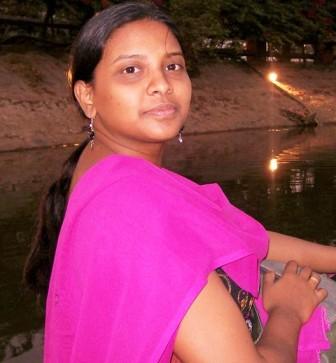T. Sowjanya
 A dalit woman colleague of mine came to the university campus wearing a mangalsutra one day and this forms the context for my discussion. An upper-caste feminist professor was a little inquisitive about the reason for wearing the mangalsutra. In a lighter mood, the dalit woman professor responded, “My parents-in-law came to visit me. They insist…” The mainstream feminist said that, “we fought such a great struggle against mangalsutra way back! And you still wear it?!” The dalit professor felt offended by this comment since it implied she was somehow a “lesser” feminist. She realized that the mainstream feminists’ construction of their body is hegemonic in many ways in that it leads to the exclusion of lower-caste/class women studying and working in the urban universities.
A dalit woman colleague of mine came to the university campus wearing a mangalsutra one day and this forms the context for my discussion. An upper-caste feminist professor was a little inquisitive about the reason for wearing the mangalsutra. In a lighter mood, the dalit woman professor responded, “My parents-in-law came to visit me. They insist…” The mainstream feminist said that, “we fought such a great struggle against mangalsutra way back! And you still wear it?!” The dalit professor felt offended by this comment since it implied she was somehow a “lesser” feminist. She realized that the mainstream feminists’ construction of their body is hegemonic in many ways in that it leads to the exclusion of lower-caste/class women studying and working in the urban universities.
It is not uncommon to find in the urban universities, many upper-caste feminists clad in ethnic, handloom clothing (either a kurti or saree), wearing terracotta/wooden/metal jewelry and a crimson red bindi on the forehead. This construction of upper-caste feminist body is partly a post-modern assertion of native culture by upholding the aboriginal skills of weaving and jewelry making. Mangalsutra is opposed by many feminists since it is a signifier of marital status of Hindu women. At the same time, it symbolically conveys that the woman is the property of her husband. Hence, the feminists’ rejection of mangalsutra is a rejection of a manifestation of patriarchy in the name of tradition. But the question here is whether the mainstream feminists have rejected all forms of patriarchy. A bindi on the forehead is a marker of Hindu woman. Constructing Hindu woman figure as the Indian/native woman figure leads to the exclusion of other women. Similarly, many feminists have neither rejected bindi nor the religious/caste position that comes from the patriarchal family structures.
The reason for the dalit professor’s discomfort has been that the construction of the upper-caste feminist body has become hegemonic since it excludes the Muslim, Christian/dalit feminists. Dalit feminists who wear mangalsutra or gold jewelry and Muslim feminists who wear burqa are often perceived to be lesser feminists or not completely free from patriarchy. But mainstream feminists too have not yet rejected certain privileges of their own social position in the intersecting caste and patriarchal structures. For example, many feminists have not rejected their surnames, family/caste names, husband names, caste/religious status. Surely, some feminists are more equal than others. While rejection of mangalsutra is considered rejection of patriarchy, rejection of caste markers have not been a significant deliberation within mainstream feminism.
The battle grounds we choose depend on the oppressive structures from which the individual and collective subjugation emanate. This is the reason why feminists are not a monolithic group. They come in different shades such as liberal feminists, radical feminists, Marxist and socialist feminists, third world feminists, black feminists, eco feminists and yes, dalit feminists. Each layer of feminism targets a particular oppressive structure that leads to the subjugation of a particular social group. For a dalit woman, the rejection of wearing gold ornaments is oppressive while for upper-caste woman, the insistence on wearing gold jewelry is oppressive.
bell hooks says, “Being oppressed means absence of choices!” Hence, such absence of choices leads dalit women to embrace marriage in certain contexts. Gopal Guru considers marriage in the case of Devadasis as the ‘rejection of rejection’ since they challenge the oppressive tradition by marrying a man and refuse to be the wife of some god or goddess. Here, marriage (though an oppressive system) in this context is “a radical alternative to fight reduction.” Similarly the case of a dalit woman professor wearing mangalsutra (or not strongly rejecting it) may be a statement on her rejection of being accessible to other men (though her parents-in-law’s insistence may be a mere imitation of Brahmanism) because the traditional ideology of considering dalit women as sexually accessible is prevalent in the urban universities as well. Such ideology is evident in cases like that of Sunita, a post graduate student of University of Hyderabad, who committed suicide after being allegedly sexually exploited by an upper-caste Reddy student from the same university. In Nagarjuna University, a dalit woman teacher committed suicide after being sexually exploited by an upper-caste male colleague. Similarly, many dalit women students have been facing sexual harassment by both upper-caste and dalit men in prestigious educational institutions of India.
Fighting different oppressive systems give rise to different schools of feminism. Even if the solidarity between different groups of feminists is abysmally low, each group sustains and fights in its own way. The problem occurs when an oppressed group consciously fights its oppression under patriarchy, but doesn’t refute its position of oppressor in relation to another social structure. For example the mainstream feminists in the premiere institutes in India today have been known to be discriminatory towards dalits and lower castes.
Another recent example is that of the controversy over Padma Aiyar’s newspaper advertisement seeking a ‘vegetarian Aiyar’ groom for her gay son. While actively fighting heteronormativity, the gay activist’s family chose to conveniently stay within the confines of the caste system. It is contradictory if a dalit actively fighting his/her oppression takes up a position of oppressor towards a gay because he or she is a heterosexual. Similarly if feminists who fight gender discrimination take up the anti-dalit position only because their position in the caste system is convenient, they are reinforcing caste and patriarchy.
If feminists have rejected sexist oppression, gendered social roles which are but a few manifestations of patriarchy, they also need to understand their own privileges of caste and class as the result of the very same patriarchal family structure because we cannot draw a clear demarcation between caste and patriarchy. Phule and Ambedkar critically explored the connection between caste and gender i.e., the control of upper-caste female sexuality is connected to the ideology of caste purity. If feminists have not rejected caste, they have not yet rejected patriarchy. By not fighting the patriarchy holistically, feminists often make choices of convenience. If upper-caste feminists’ goal is only to occupy the position of upper-caste man who dominates both the public and private spheres of social life, the struggle is not only incomplete but also unjust towards other social groups. Antoinette Fouque says, “The difference between sexes is not whether one does or doesn’t have a penis, it is whether or not one is an integral part of a phallic masculine economy.”
~
References
* Fouque, Antoinette, “Warnings,” in New French Feminism. Eds. Elaine Marks and Isbelle De Courtivron. Amherst: University of Massachusetts Press, 1980, pp.177-18.
* Guru, Gopal, “Rejection of Rejection: Foregrounding Self-respect” in Gopal Guru (Ed), Humiliation: Claims and Context. New Delhi: Oxford University Press, 2009,pp, 209-25.
* Hooks, Bell. Feminist theory: From Margins to Center, New York: South End Press, 2000.
~~~
Sowjanya teaches at the Tata Institute of Social Sciences, Hyderabad. Her research interests are in the area of gender, caste, media and culture studies.










